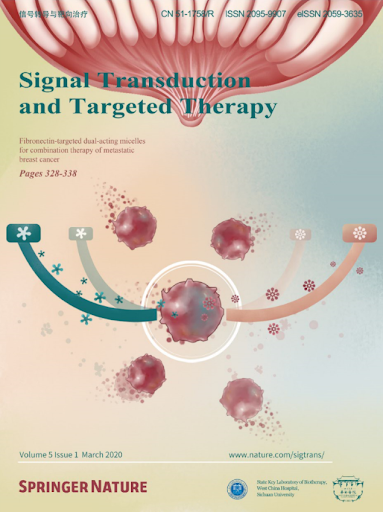Differential expression pattern of CC chemokine receptor 7 guides precision treatment of hepatocellular carcinoma.
IF 52.7
1区 医学
Q1 BIOCHEMISTRY & MOLECULAR BIOLOGY
引用次数: 0
Abstract
The treatment of hepatocellular carcinoma (HCC) faces challenges of low response rates to targeted drugs and immune checkpoint inhibitors, which are influenced by complicated microenvironment of HCC. In this study, the complex tumor microenvironment was identified by using tissue microarray (TMA), spatial transcriptomes and single-cell sequencing. High expression of CC chemokine receptor 7 (CCR7) in tumor cells predicted lower Overall Survival (OS). Conversely, CRISPR-Cas9-mediated knockout of CCR7 enhanced the sensitivity of HCC to sorafenib in preclinical experiments, resulting from the inhibition of epithelial-mesenchymal transition through the AKT and ERK signaling pathways. Simultaneously, we revealed CCR7 expression in stromal cells, with increased infiltration of CCR7+ immune cells into the tumor mesenchyme associated with high CCL21 expression at tumor sites. Subsequently, VEGF-C was identified as an independent predictor of higher patient OS and showed a significant positive correlation with CCR7 signaling. Interestingly, exogenous VEGF-C was found to promote the formation of tertiary lymphoid structures (TLSs) by activating lymphatic angiogenesis and the CCL21/CCR7 axis. As a result, VEGF-C treatment enhanced the efficacy of anti-PD-1 immunotherapy. This study highlights the opposing effects of tumor cell-derived versus stromal cell-derived CCR7 expression and guides the precision treatment for HCC.CC趋化因子受体7的差异表达模式指导肝癌的精准治疗。
肝细胞癌(HCC)的治疗面临着靶向药物和免疫检查点抑制剂应答率低、受HCC复杂微环境影响的挑战。在本研究中,通过组织微阵列(TMA)、空间转录组和单细胞测序鉴定了复杂的肿瘤微环境。肿瘤细胞中高表达CC趋化因子受体7 (CCR7)可预测较低的总生存期(OS)。相反,在临床前实验中,crispr - cas9介导的敲除CCR7增强了HCC对索拉非尼的敏感性,这是由于AKT和ERK信号通路抑制了上皮-间质转化。同时,我们发现CCR7在间质细胞中表达,CCR7+免疫细胞向肿瘤间质浸润的增加与肿瘤部位CCL21的高表达相关。随后,VEGF-C被确定为患者OS较高的独立预测因子,并与CCR7信号传导呈显著正相关。有趣的是,外源性VEGF-C被发现通过激活淋巴血管生成和CCL21/CCR7轴来促进三级淋巴样结构(TLSs)的形成。因此,VEGF-C治疗增强了抗pd -1免疫治疗的疗效。本研究强调了肿瘤细胞来源的CCR7表达与基质细胞来源的CCR7表达的相反作用,并指导了HCC的精确治疗。
本文章由计算机程序翻译,如有差异,请以英文原文为准。
求助全文
约1分钟内获得全文
求助全文
来源期刊

Signal Transduction and Targeted Therapy
Biochemistry, Genetics and Molecular Biology-Genetics
CiteScore
44.50
自引率
1.50%
发文量
384
审稿时长
5 weeks
期刊介绍:
Signal Transduction and Targeted Therapy is an open access journal that focuses on timely publication of cutting-edge discoveries and advancements in basic science and clinical research related to signal transduction and targeted therapy.
Scope: The journal covers research on major human diseases, including, but not limited to:
Cancer,Cardiovascular diseases,Autoimmune diseases,Nervous system diseases.
 求助内容:
求助内容: 应助结果提醒方式:
应助结果提醒方式:


